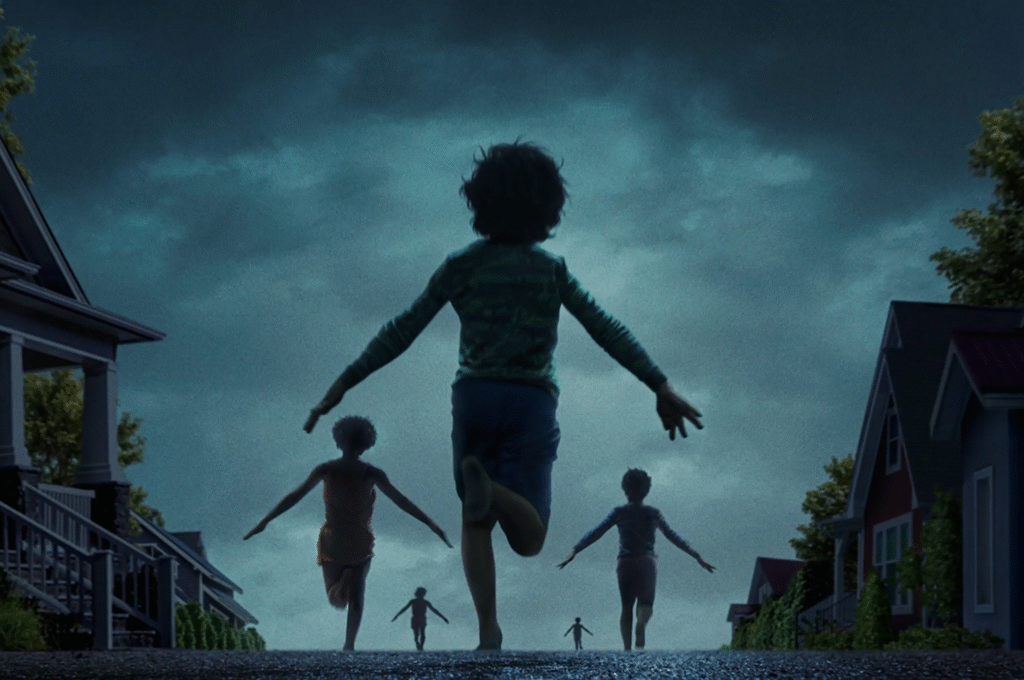
Zach Cregger’s Weapons was released this weekend to widespread critical and audience acclaim. The film follows the residents of a small town after 17 children mysteriously vanish in the middle of the night. While it is nominally a horror film (and it is scary), Weapons is also laugh-out-loud funny. Prior to Barbarian, Cregger was best known as a member of the comedy troupe The Whitest Kids U’ Know. His comedic background shines through in many scenes, however, this does not detract from the horror. Rather, the balance of comedy and horror enhances both elements. The jarring tonal shifts catch you by surprise; going from a jump scare to a joke is a hell of a roller coaster ride.
What really stood out to me about this movie was how perfectly suited it was for theatrical viewing. Recently, films that do well at the box office are often the ones that promote spectacle. A common theme among modern large-scale releases is the promotion of the format the film was shot in. Formats like IMAX, 70mm, or VistaVision are proudly displayed on posters and trailers. These films want you to know that theatrical viewing is required to fully appreciate the film as the filmmaker intended. I love these movies; the theater is truly the best place to watch a big-budget action or adventure film. However, this trend has seemingly created an attitude among studios that films slated for theatrical release need some form of large-format gimmick. The Dune, Top Gun, and F1 films of the world are strategically designed with some form of large-format theatrical release in mind.
Weapons is no different; it was shot in IMAX and has heavily promoted viewing the film in an IMAX theater. However, the film itself doesn’t rely on IMAX in the same way as the other films mentioned above. I believe that Weapons would be just as successful an experience if it was not shot in IMAX. This is because the movie is fun.
I understand the calculus behind “exotic format” marketing. Why spend the money on a widespread theatrical release when the film doesn’t require it? A small-scale drama or goofy comedy isn’t going to rely on a grand format to be successful. However, what a film like Weapons highlights is the importance of a shared viewing experience. The shared experience of watching a film in a packed room of strangers adds an entirely different element to the viewing experience. I saw Weapons in a packed theater. The collective gasps in response to a jump scare or the eruption of laughter in the theater added an additional layer to the viewing experience that simply cannot be replicated at home.
Laughter is contagious. There is a reason that blooper reels from popular comedies get so many views online. Watching Danny McBride break in Eastbound & Down bloopers or the entire cast die laughing in Always Sunny bloopers is so great because watching someone laugh is often just as funny as the underlying joke. Watching Weapons in theaters, the person seated next to me was laughing uncontrollably at a scene near the end of the film. Initially, they were the only person laughing in the theater, but as the scene continued, other people began cracking up not only because the scene was so funny, but also because the person next to me was laughing so hard. The laughter started a chain reaction throughout the theater, and by the end of the scene, everyone was laughing. It was the kind of experience that I had sorely missed and forgot even existed until that moment.
Theaters are in dire need of films that are fun. Theatrical releases don’t need large formats to be successful. The most memorable theater-going experiences are the ones in which audiences bond over the shared experience of watching what’s on screen. I saw The Brutalist in a packed theater. The VistaVision format looked incredible on the big screen, but the film itself was not the type that was conducive to a shared audience experience. I liked the film, but it was not “fun” by any stretch. It was an internal, quiet character study and frankly quite bleak. Yet, the film was zealously marketed as a theatrical experience. Its format was the only reason it was marketed so heavily as a unique theatrical experience. I am always in favor of watching films in the theater, but I wish films with traditional formats were given the same attention because of how fun they are to see in a room full of strangers.
Sometimes, the experience of seeing a movie in theaters becomes more memorable than the movie itself. I remember seeing Harry Potter and the Half-Blood Prince on opening night. The theater was jam-packed back in a time when theaters had regular seating, not reduced luxury seating. There were nearly 200 people in the room that night. After the scene where Dumbledore dies (spoiler), the entire room was dead silent—you could hear a pin drop. Some teenager seized the moment and, with perfect timing, shouted “WAKE UP!” at the top of his lungs. The entire theater jumped and gasped. The shout was a perfectly timed jump scare. The crowd then broke out in an uproar of laughter for being so easily had by the shouting teen. While it was a bit of a dick move, it was the type of shared experience that simply doesn’t happen anymore in theaters.
Like a live performance, the crowd at a packed theater can have a large impact on the viewing experience. A “good” crowd can take a good movie and make it great. I was fortunate enough to see Weapons with a great crowd—a crowd that was fully invested in the film and reacted viscerally. Huge budgets and exotic formats are not necessary to make a successful theatrical film. Films can be great simply because of the experience they cultivate among an audience.
Leave a Reply